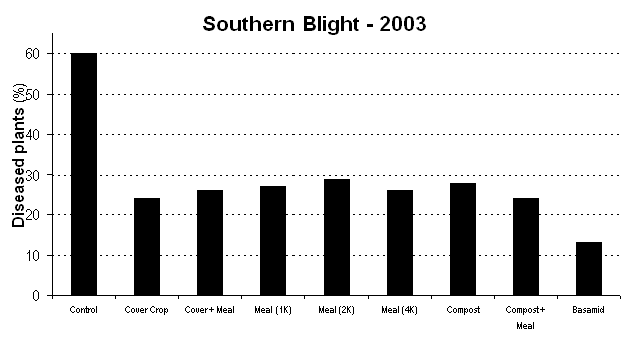Mustard Meal as a Component of Integrated Systems for
PlasticultureTomato Production
Knoxville Experiment Station, 2003.
Martin Lyons and Carl Sams
Interpretive Summary
Mustard meal can act as an alternative to synthetic fumigants for the control of soilborne diseases in plasticulture vegetable production. When activated in moist soil this biofumigant releases the bioactive compound, isothiocyanate.
Introduction
Biofumigation is the process of incorporating bioactive compounds into the soil and utilizing the release of volatiles for pathogen suppression. The viability of biofumigation to control soilborne diseases has been investigated for many years. Our current project, funded through the Southern SARE program, is focused on developing an integrated production system that combines an enhanced form of biofumigation with the many benefits of composts. Research has shown that certain Brassica cover crops, as well as mustard seed meal, contain high concentrations of isothiocyanates (ITCs). The seed meal is also a significant source of nitrogen and other nutrients. When incorporated into the soil ITCs act as an effective biofumigant, reducing populations of pathogenic fungal species (Sclerotium, Rhizoctonia, and Phytium), nematodes, weeds, and certain insect species. Compost incorporation improves plant health and productivity due to enhanced soil nutrient levels and improved physiochemical properties, including increased water-holding capacity.
The control of soilborne diseases through the use of chemical fumigation has several inherent problems. Commercially available synthetic fumigants have potential for toxicity and persistence in soil with a resulting threat of groundwater contamination. The gaseous by-products of fumigants such as methyl bromide have been targeted as class-1 ozone depletors. Concerns for the safety of farm workers that handle such compounds is an important issue, as are elevated costs of application. Fumigants act to sterilize the soil, however, either residual or re-introduced pathogens can quickly re-populate in the subsequent weeks and months. Biologically based management techniques both suppress pathogen numbers and re-establish a balanced soil microecology that is capable of providing extended and sustainable disease suppression.
An expansive field experiment was conducted during the 2003 growing season on the lower field of the Knoxville Experiment Station. An integrated strategy of biologically based treatments was tested to assess their level of disease management and ability to enhance tomato yields.
Materials and Methods
Field studies:
The three-quarter acre research site contains 120 replicates (25 x 4 ft. each) representing nine experimental treatments and one control. The 2003 field treatments are displayed in Table 1. The rows were prepared with raised beds, black plastic mulch, and trickle-tape irrigation/fertigation. The 1440 "Celebrity" tomato transplants were greenhouse grown and transplanted in mid-May. Yield data was collected throughout the season. Each plant was assessed for the occurrence of Southern Blight. This data was also collated and compared to treatment type.
Results and Discussion
Tomato yields for the plants grown in the treated plots were higher than the control (Fig.1). Fruit yields for the controls averaged 9.6 lbs per plant. Plots amended with an incorporated Brassica cover crop averaged 11.6 lbs of fruit per plant, a 21% increase above the control plants. When meal was also added to the incorporated cover crop, yields increased to 13.1 lb/plant, 37 % above controls. Mustard meal used as an amendment alone also resulted in yields increases. The 4000 lb/acre rate had the greatest impact. This treatment elevated yields to 13.7 lb/plant, a 43% increase above controls. The largest increases in tomato yields came from the plants grown in soil that had been amended with spent mushroom compost as well as mustard meal (2000 lb/acre). These plants produced 54% more fruit than the control plants. The data supports the concept that adding organic matter to production soils will enhance yields. Integrating two or more organic treatments, such as Brassica (mustard) plant tissue and compost is favorable. The superior yields can be attributed to an increase in available nutrients in combination with improved physical and chemical soil properties.
The phytopathogenic fungus, Sclerotium rolfsii, causes southern Blight. This organism is favored by warm, humid conditions and is directly responsible for major losses in a variety of crops that utilize plasticulture production. Commonly controlled by pre-plant soil fumigation with chemicals such as methyl bromide, biologically based treatments have shown promise as an alternative, sustainable disease management tactic. A high incidence of disease was observed in the control plots of our experiment. Sixty percent of control plants developed symptoms of Southern Blight (Fig.2). This percentage was significantly reduced in all of the experimental treatments. The chemical fumigant, Basamid, reduced disease to 13% of all plants. Biofumigation, utilizing mustard meal or a Brassica cover crop, reduced disease to 24-29% of all plants. Interestingly, the rate of meal used did not impact disease suppression. The 1000, 2000, and 4000 lb/acre rates had similar results. In contrast to fruit yield, the integrated treatments were not more effective at controlling disease than each treatment alone.
Table 1. Field treatments for 2003.
|
2003 Pre-Plant Soil Treatments |
|
Biofumigation via Brassica cover crop |
|
Biofumigation with cover crop - mustard meal @ 2000 lb/acre |
|
Biofumigation with mustard meal @ 1000 lb/acre |
|
Biofumigation with mustard meal @ 2000 lb/acre |
|
Biofumigation with mustard meal @ 4000 lb/acre |
|
Spent Mushroom compost @ 30 ton/acre |
|
Biofumigation (meal) + Compost |
|
MITC (Basamid) @ 350 lb/acre |
|
Control |

Figure 1

Figure 2